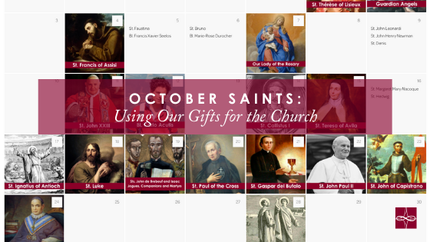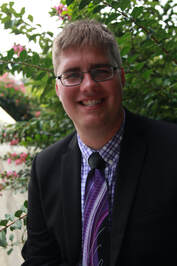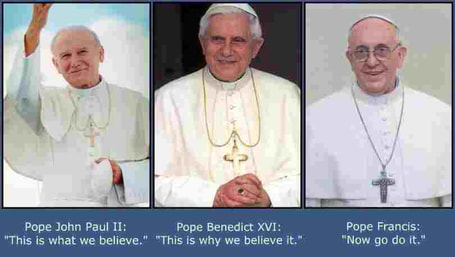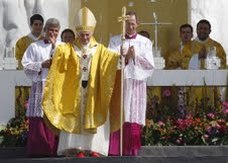|
This October, as summer turns to fall and the days start getting shorter, we sometimes find ourselves with opportunities to reflect on some of life’s bigger questions. I often find myself this season asking deep questions on a nice walk outside while admiring the beauty of nature. A lot of times, these big life questions usually involve prayer, discernment, and looking to role models. When I sat down to look at the saints whom we celebrate this October, I realized that many of them had to face similarly tough life questions. The popes, young people in the Church, and martyrs we celebrate this October can help us grow in our own faith journey. Pope Saints Next week, we will celebrate two saints who were popes, albeit at vastly different times. On October 14th, we will celebrate the feast of St. Callistus I (also know as Callixtus I). For many, he is probably one of the lesser-known pope saints. He was the 16th pope and had to deal with great division in the Church. He was able to navigate the Church through many doctrinal controversies through these turbulent times and was martyred around the year 222. Similarly, St. John XXIII navigated through many challenging questions in the Church when he opened the Second Vatican Council in 1962. It was through much prayer and discernment that both popes were able to guide the Church out of murky waters. Later this month, we will celebrate Pope St. John Paul II. One of my favorite John Paul II quotes epitomizes the courage he calls all of us to in living out our faith: “Do not be afraid. Do not be satisfied with mediocrity. Put out into the deep and let down your nets for a catch.” Saints who had an impact in their youth Already this month, we have celebrated two saints who had a major impact on the Church while in their youth: St. Thérèse of Lisieux and St. Francis of Assisi. St. Thérèse, who died at 24, was known for her life of fervent prayer. She was a cloistered Carmelite nun whose prayer was not focused on herself, but on the whole world. She is known as one of the patron saints of missionaries even though she lived as a cloistered nun. St. Francis of Assisi also had a huge impact on the Church while still young. St. Francis was in his 20s when he heard God’s call in the chapel at San Damiano, but it took him time and further prayer to realize God’s true calling for him. St. Francis’ perseverance in the faith and continual discernment of God’s call, even in times of confusion, inspire me. Bl. Carlo Acutis, beatified just last year, also positively impacted the Church in his youth. Bl. Carlo was an amateur computer programmer who died in 2006 at the age of 15. He used his passion for computers to create a website documenting Eucharistic miracles across the world. Martyrs from all ages Throughout the rest of the month, we will celebrate the feast days of martyrs from all time periods in the Church. This includes the memorial of two Apostles: Sts. Simon and Jude. While not much is known about the lives of Sts. Simon and Jude, it is known that they both were killed for their faith. Also martyred in the time of the early Church was St. Ignatius of Antioch. He is known for his incredible writings on Christology. St. Denis was also a martyr in the time of the early Church. Many portrayals of St. Denis will show him holding his head in his arms because after his was martyred, legend has it that he held his head and shared Christ with those who killed him. On October 19th we will celebrate Sts. John de Brebuf and Isaac Jogues, the patron saints of North America. They were killed in the 17th century while ministering to the Iroquois. Even though they had previously been captured and knew that they could be killed, they placed all of their trust in God and continued their missionary work. Throughout the rest of this October, let us pray for the intercession of these saints in helping us be courageous in prayer and discerning God’s continuing will for us. To learn more about the saints, visit our Catholic Feast Days Website by clicking here. To view a calendar of the feast days in October, and each month, click here.
0 Comments
It was a fairly normal March afternoon and I was at my computer working on my senior project, with a livestream of the Conclave playing in the background from Salt+Light TV. The anchors were discussing all the possibilities facing the Church, which of the “papabile” was the most likely candidate, and reflecting on the pontificate of Benedict XVI. Then I heard it, like a bell suddenly pealing out in the middle of the night: “And it looks like we have black smoke again… Actually, it’s looking a little greyish… Wait a minute… White smoke! WE HAVE WHITE SMOKE! The Cardinals have elected the next Pope!!” My heart leapt with excitement as I ran to the TV to watch coverage on the news. Every major network had had their eyes fixed on Rome since the College of Cardinals began arriving for Conclave. Every night the news would show video of that little smokestack on the roof of the Sistine Chapel. But this night was unlike any other night in recent memory. The white smoke, the “fumata bianca," had been spotted: the Church had Her new Vicar of Christ! My thoughts quickly jumped back to my freshman year of high school, the year Pope Benedict XVI was elected. It was all new to me then, as John Paul II had been Pontiff for my entire life. This time was different: I understood what the Conclave was, how it worked, and what to expect when the new Pope was revealed to the world. When “Cardinal Protodeacon” Jean-Louis Tauran came to the loggia of St. Peter’s, it felt as though the whole world held its breath. Even the news anchors had gone silent until the words “Habemus Papam," which caused the crowd in the piazza to explode with cheers. Though there was confusion as to who this Cardinal Bergoglio was, it was quickly forgotten when his chosen name was announced: Francis, the first Pontiff ever to take the name of one of the world’s most well-known and beloved saints. Clearly, this new Pontiff had plans to set the bar high. St. Francis is, after all, most well-known for his simple lifestyle of meekness and poverty. When he stepped out onto the balcony, Pope Francis did not disappoint. He looked overwhelmed and nervous, yet very much at peace with the decision of the Cardinals. He warmly greeted the crowd and then, to everyone’s shock, bowed before the whole world to ask each of us for our prayers. It was a poignant gesture, the likes of which the world rarely sees these days. I myself was nearly moved to tears, as this man, whose name I’d never even heard before, was bowing and asking me for my prayers as he took up the hardest job in the Church. It was a touching moment I’ll not soon forget. In the year that has passed since then, Pope Francis has remained consistent in his message of evangelizing by authentic Christian living. Much like his namesake, who is often paraphrased as saying “preach the Gospel at all times; use words when necessary," Francis has spent his pontificate challenging Christians everywhere to practice what we preach, in both word and deed. Even in the face of hot-button political issues, he successfully reminds the world that each person and situation we meet is an opportunity to encounter Christ and share His message. In our meme-driven world of social media, there have been many images created to try and encapsulate various aspects of Pope Francis’s message in both witty and moving ways. There is one, however, that paints a beautiful picture of continuity between Francis and his two predecessors: It has been said that Pope Francis has a radical new approach to Catholicism. This is a rather naïve analysis; he is presenting a two thousand year old message in a simple and authentic manner. It’s not that Francis is telling the world anything particularly earth-shattering, it’s that he’s challenging the world without us realizing it. His demeanor is warm and inviting, but his message is a true call to action. It isn’t enough to simply profess faith; we must live it daily in order to meet and serve Christ Himself in others.
As we celebrate the first year of Pope Francis’s pontificate, we continue to pray for him and for the Church. May our work model the example set by the Holy Father: “Let us learn from Christ how to pray, to forgive, to sow peace, and to be near those in need.” –Pope Francis, Feb 18, 2014 Viva il Papa! Jay Schaefer is the Webinar Associate for the Catholic Apostolate Center There are many places in life where we find joy. Often times, I find joy in my family – going home for holidays and being with the people that I love the most. I find joy in my friends – a second family that arguably knows me best. I find joy in my work – encouraging others to support an institution that means so much to not only me, but also to the Church in the United States. When I think of my Catholic faith, I can only think of joy. This was especially evident during the recent election of a new Pope when I saw the entire world rest its eyes on our Church. It gave me great joy to answer people’s questions about my faith, help them to learn more about what it means to be Catholic, and strengthen my own faith. Joy in our faith can be found in a variety of different contexts. The one place where I find the most obvious joy, however, is within the hymns and songs of praise that are sung so beautifully in churches throughout the world. Over this past Triduum and Easter Sunday I heard magnificent music that brought people to tears.. One thing which astounds me every time I attend Mass is that it doesn’t matter if you can sing or not – liturgical music is meant to be sung by anyone. The entire congregation is meant to join in and sing their praise to God. You can see visually the people around you either belting their notes or perhaps listening intently to those around them. Whichever way one chooses to participate, there is no doubt that you can find Joy within the music both sung and played. One of the things I like to do immediately upon entering a pew is to figure out what hymns are going to be sung as the processional and recessional. If I don’t know the hymns, I try to hum the notes to myself in an effort to learn before the music starts. When the organist starts playing, I am transported – if only for a few brief moments – to a place of Joy. The people singing around me are all focused on one thing: praising God, saying thank you for giving us this day, and joining together to start off their week on the right foot. As I was writing this post, I stopped to go to Mass in downtown Washington, DC. Again, the music chosen immediately brought me into the moment. Each liturgical season brings with it an amazing group of hymns. Everyone I’ve spoken to have their favorites, especially at Christmastime. As for me, I’m a sucker for Easter hymns. Whatever the case may be, liturgical music has a way of bringing us closer to God in so many ways. Next time you’re at Mass, take it in – notice that everyone around you is all focused on the same thing: praising God and thanking him for giving us this day. What’s my favorite hymn? Too many to choose from, but I’ll leave you with this beautiful piece of music that I think anyone can appreciate – especially when you least expect it. Chris Pierno is the Media and Marketing Manager for the Catholic Apostolate Center. Editor's Note: This post was originally published on April 25, 2013 There are many places in life where we find joy. Often times, I find joy in my family – going home for holidays and being with the people that I love the most. I find joy in my friends – a second family that arguably knows me best. I find joy in my work – encouraging others to support an institution that means so much to not only me, but also to the Church in the United States.
When I think of my Catholic faith, I can only think of joy. This was especially evident during the recent election of a new Pope when I saw the entire world rest its eyes on our Church. It gave me great joy to answer people’s questions about my faith, help them to learn more about what it means to be Catholic, and strengthen my own faith. Joy in our faith can be found in a variety of different contexts. The one place where I find the most obvious joy, however, is within the hymns and songs of praise that are sung so beautifully in churches throughout the world. Over this past Triduum and Easter Sunday I heard magnificent music that brought people to tears.. One thing which astounds me every time I attend Mass is that it doesn’t matter if you can sing or not – liturgical music is meant to be sung by anyone. The entire congregation is meant to join in and sing their praise to God. You can see visually the people around you either belting their notes or perhaps listening intently to those around them. Whichever way one chooses to participate, there is no doubt that you can find Joy within the music both sung and played. One of the things I like to do immediately upon entering a pew is to figure out what hymns are going to be sung as the processional and recessional. If I don’t know the hymns, I try to hum the notes to myself in an effort to learn before the music starts. When the organist starts playing, I am transported – if only for a few brief moments – to a place of Joy. The people singing around me are all focused on one thing: praising God, saying thank you for giving us this day, and joining together to start off their week on the right foot. As I was writing this post, I stopped to go to Mass in downtown Washington, DC. Again, the music chosen immediately brought me into the moment. Each liturgical season brings with it an amazing group of hymns. Everyone I’ve spoken to have their favorites, especially at Christmastime. As for me, I’m a sucker for Easter hymns. Whatever the case may be, liturgical music has a way of bringing us closer to God in so many ways. Next time you’re at Mass, take it in – notice that everyone around you is all focused on the same thing: praising God and thanking him for giving us this day. What’s my favorite hymn? Too many to choose from, but I’ll leave you with this beautiful piece of music that I think anyone can appreciate – especially when you least expect it. Chris Pierno is the Associate for Media and Marketing for the Catholic Apostolate Center. "Shock." "Disbelief." "Uncertainty." "Bittersweet." The above descriptors were all used by friends to describe their reaction to last week’s resignation announcement by Pope Benedict XVI. I awoke at 6:02am last Monday to several text messages from friends informing me of the reported, yet still unconfirmed, “shot heard round the world.” The resignation of our Holy Father, at first, felt like the loss of a grandparent that you have grown up with; I have grown up in the Church of Pope Benedict XVI. After letting the news sink in over the last week, I have found some inspiration in Psalm 30:6, which speaks of sorrow leading to rejoicing: “Weeping may linger for the night, but joy comes with the morning.” My sense of loss has been transformed into a greater sense of admiration for a man that I have never met, yet have such a deep respect for. For lack of something more appropriate to say, I offer to you the words of the Holy Father during his homily at the Final Mass of the 26th World Youth Day in Madrid, Spain on August 21, 2011. May his words serve as a challenge to all of us during the last days of his momentous pontificate. Oremus pro Pontifice et pro invicem. Dear young friends, as the Successor of Peter, let me urge you to strengthen this faith which has been handed down to us from the time of the Apostles. Make Christ, the Son of God, the center of your life. But let me also remind you that following Jesus in faith means walking at his side in the communion of the Church. We cannot follow Jesus on our own. Anyone who would be tempted to do so “on his own”, or to approach the life of faith with that kind of individualism so prevalent today, will risk never truly encountering Jesus, or will end up following a counterfeit Jesus. Having faith means drawing support from the faith of your brothers and sisters, even as your own faith serves as a support for the faith of others. I ask you, dear friends, to love the Church which brought you to birth in the faith, which helped you to grow in the knowledge of Christ and which led you to discover the beauty of his love. Growing in friendship with Christ necessarily means recognizing the importance of joyful participation in the life of your parishes, communities and movements, as well as the celebration of Sunday Mass, frequent reception of the sacrament of Reconciliation, and the cultivation of personal prayer and meditation on God’s word. In closing, I share with you a rendition of Tu es Petrus, composed by Cardinal Domenico Bartolucci, Director Emeritus of the Sistine Chapel Choir, performed during World Youth Day in Madrid. Alex R. Boucher is the Program & Operations Coordinator for the Catholic Apostolate Center. Follow Alex on Twitter at @AlexBoucher.
|
Details
Archives
July 2024
Categories
All
|
About |
Media |
© COPYRIGHT 2024 | ALL RIGHTS RESERVED






 RSS Feed
RSS Feed